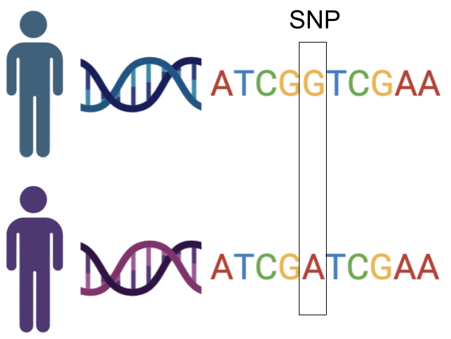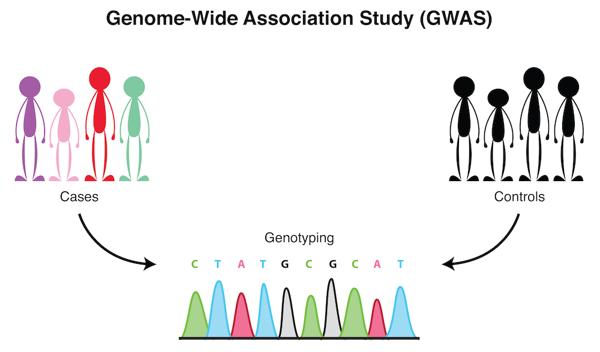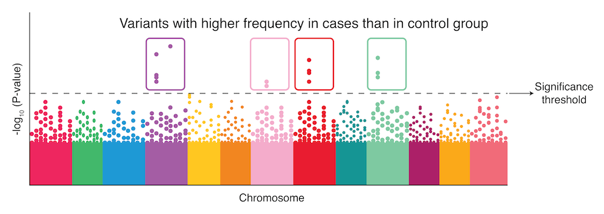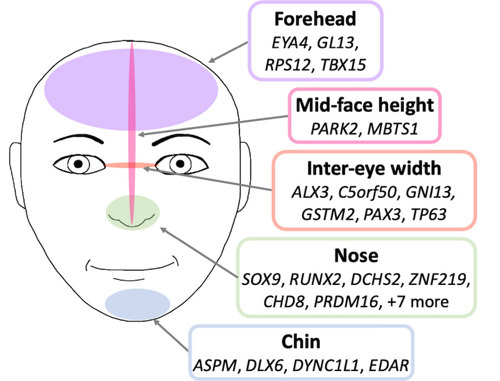
What do we know about the genetics of facial appearance?
July 18, 2023

- Related Topics:
- Appearance,
- Genetic variation,
- Bioinformatics,
- Genotype and phenotype,
- Genotyping
A biochem student from San Francisco asks:
"What do we know about the genetics of facial appearance? I know that there are lots of genes that cause pathological changes to the face or which cause unusual facial appearance as part of a genetic syndrome like Down's syndrome. But what genes are involved in why, for instance, I look like more like my parents than a random person on the street?"
That is a great question that we still don’t know the full answer to! There are actually many different genes involved to make you look like your parents.
We look more like our parents than strangers, because we get half of our DNA from each parent. As a result, your DNA is a mixture of both parents' genes. But which genes are responsible for which parts of our face?
This has been a difficult question to answer in the past because we have ~20,000 genes in our body. That is a lot of genes to study. Luckily with advances in technology, scientists found a fast way to narrow down some genes that are associated with facial variation. However, we are still only scratching the surface of this topic and there is still a lot more to research!

SNP-pets of our DNA
All human beings are 99.9% identical in their genetic makeup. But the 0.1% that is different is enough to make us different in millions of ways, including how we look.
The 0.1% genetic difference can come from single letter changes to the DNA. DNA is made up of four bases (A, T, C, G) and sometimes a person will have an G base instead of an A in a specific place. These base changes are called Single Nucleotide Polymorphisms (SNPs). SNPs can vary in frequency within the population and amongst different populations. This little snippet of DNA allows scientists to be able to tell individuals apart.

Geno-Typing away at the genomes
The little difference in a snippet of DNA is enough for scientists to study facial features in many different populations of people. Scientists came together to perform a large study to look at many different SNPs (~ 1 million) on the entire genome to see if SNP frequencies between populations are associated with phenotypic traits such as facial features. This is called a Genome Wide Association Study (GWAS). The process of looking at the SNPs of an individual is called Genotyping.
To be able to look at SNP differences between different populations, and how the SNPs are associated with phenotypic traits, scientists had to genotype two different groups. The two groups are a control group and a case group (a group with a certain phenotype).

GWAS for the Face
To gain insight into what regions of our DNA are associated with facial features, scientists did GWAS analysis of over 8000 individuals. The individuals had their face scanned to define what facial features they had. Scientists were so detailed that they divided the face into 63 parts for their study!1
Scientists then use statistics to calculate SNPs that occur at a higher frequency in one group than another (like in the image below). If the region with a SNP (colored dot) is above a baseline level (dotted line), then it might be significant.

From these kinds of studies, scientists have found over >200 DNA regions with significant signals that are associated with normal facial variation.
For example, when scientists wanted to look at forehead protrusion, they looked at two groups: people with forehead protrusions and people without. When they looked into the SNP differences between the two groups, they found that a SNP located in the SMG6 gene region was strongly associated with forehead protrusion.2 We can use this same method to analyze which parts of the DNA are associated with all different types of facial features.
While I can’t give you an exhaustive list of which genes are involved in making certain parts of the face (there are too many to list and most are still being researched!), I can give a few examples. The diagram below will show you which genes have been found to be associated with which parts of our face.

The face is complex
Research on genes involved in facial structure is ongoing and detailed. Oftentimes, a single trait such as a round nose involves many different DNA regions and it is difficult to point to just a single gene responsible for it. It would be great to revisit this question in ten years and see what scientists have discovered!

Author: Christy Luong
When this answer was published in 2023, Christy was a Ph.D. candidate in the Department of Chemicals and System Biology, studying the mechanisms of random monoallelic expression in Howard Chang’s and Joanna Wysocka’s laboratories. Christy wrote this answer while participating in the Stanford at The Tech program.
 Skip Navigation
Skip Navigation
